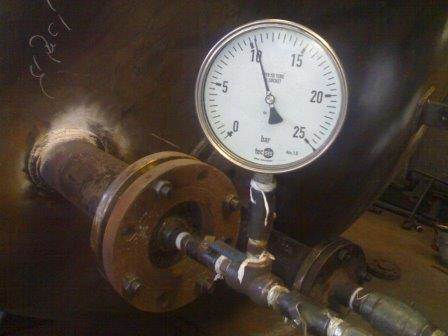What is the Nonconformity Report (NCR)?
The Nonconformity report is a supplementary document for source inspection report when a nonconformance being observed.
Nonconformity Report Example

For example, a third party inspector (under contract with purchaser) attends to supplier facility to witness a hydrostatic test and also to verify (document review) the material test reports and NDE test reports.
He reviews the approved drawing and realizes the test pressure is 400 psi and subsequently review the approved hydrostatic test procedure and starts to witness the test.
The supplier increases the pressure step by step to reach 400 psi. Based on the procedure the pressure shall be held up for 1 hours. The everything goes smooth until after 45 min the vessel pressure drops suddenly.
The inspector checks vessel body and weld seams and turns out one of the nozzle to shell weld joint is leaking. He realizes water droplet is continuously forming and drops to the floor.
The test stops and supplier drains the water from the vessel. The hydrostatic test was failed for Nozzle to shell joint defect and failure.
In the next step, the supplier provides the inspector by material test report and NDE test reports. He reviews the test reports with satisfactory result.
The inspector writes source inspection report and one NCR report. He writes his source inspection report and indicates how he checked material test report and NDE test reports and also mentions the result of the review.
Similarly, he explains about the hydrostatic testing report and how the vessel failed under hydrostatic testing pressure.
Besides, he has to fill out a nonconformity report. A nonconformity report generally contains the following information:
- Customer data such as name, location and contact person
- Supplier data such as name, location and contact person
- Order data such as purchase order No., date of NCR, Tag No., etc.
- Details of nonconformance; here the inspector explains the detail of incident and how the vessel nozzle to shell joint failed under hydrostatic pressure
- Proposed Corrective Action; this part generally is filled by the supplier and indicates how the supplier wants to fix the issue, and normally there are 3 fields for check mark ( accept as is, repair/rework, reject & replace) with one narrative box. The supplier picks one of above 3 mentioned options and explains how they are going to fix it.
In the end, there are some fields for customer approval and responsible people.
In this example, the supplier can tick mark the "repair/rework" section and in the narrative section can explain that leaked area will be removed by grinding, and the surface will be subjected to dye penetration test to ensure the defect completely being removed.
In next step, they will weld back by approved repair weld proceduer and make dye penetration test after completion of welding. Then they will notify the inspector to witness hydrostatic testing.
As mentioned in above, the NCR report is a supplementary report for source inspection report to explain what will be the correction action and how the customer will approve this correction action.
Any customer has own nonconformity report and procedure and it may different from one customer to the another one.
Free newsletter!
Sign up to receive my monthly newsletter covering all the latest courses and updates.




New! Comments
Have your say about what you just read! Leave me a comment in the box below.